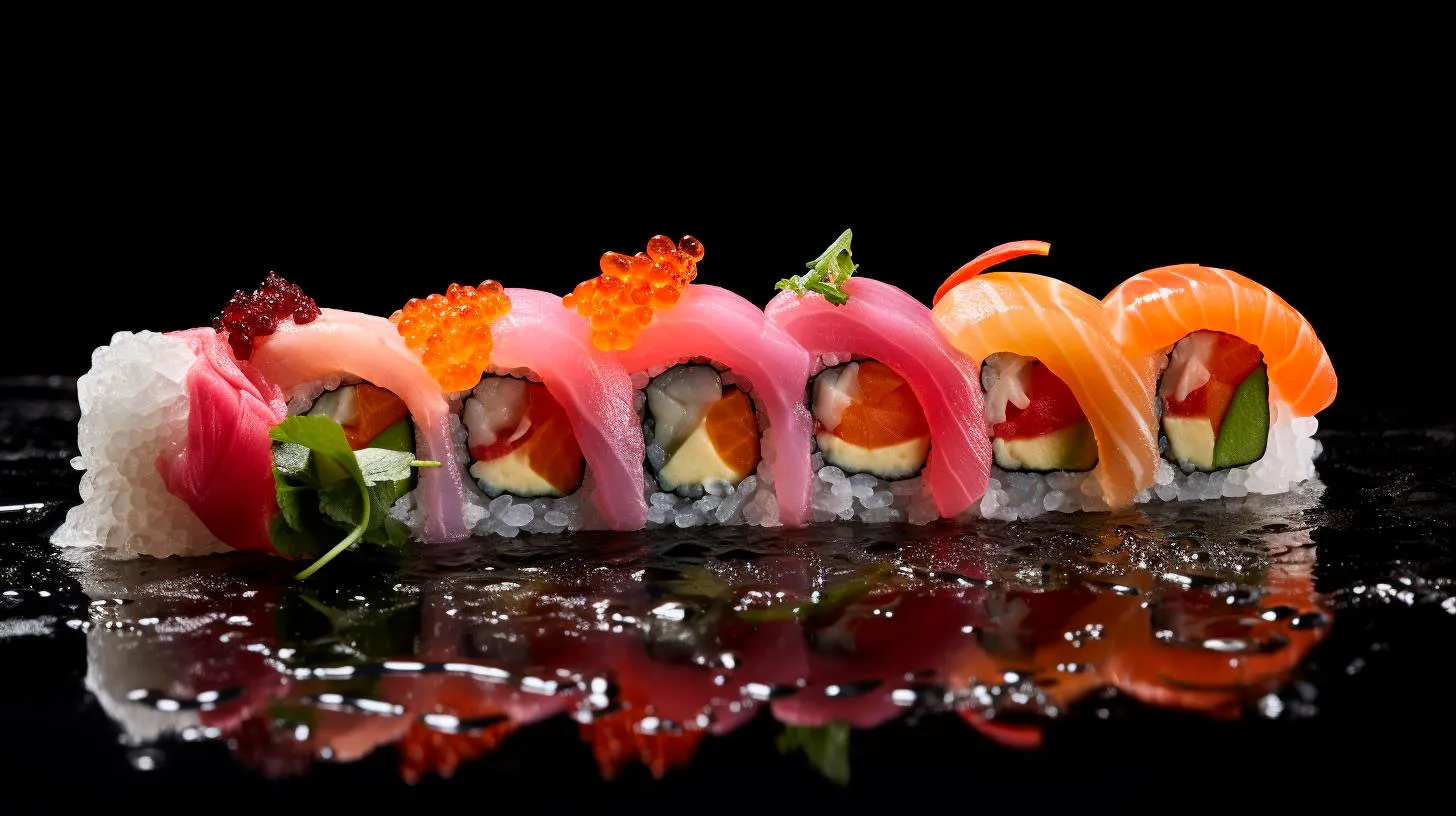Nori From Ancient Craft to Modern Process
In this article, we will explore the rich history of nori, its modern production methods, and its wide range of applications.
The History of Nori: A Timeless Delicacy
The origins of nori can be traced back to Japan’s Edo period (1603-1868). At that time, nori was harvested by hand along the country’s coastline, particularly in the Seto Inland Sea, Tokyo Bay, and the Ariake Sea. The process involved carefully collecting young seaweed, which was then sun-dried and pressed into paper-thin sheets. This traditional method of nori production was a labor-intensive task performed by skilled artisans.
Fast forward to the 20th century, nori production underwent a revolutionary change. Following the introduction of the first nori-making machine in 1946, the production process became more efficient and widespread. Today, Japan is the leading producer of nori, with over 600,000 tons produced annually. The development of modern nori production techniques has not only increased the availability and affordability of this delicacy but has also allowed for its export to other countries, making it a global culinary phenomenon.
The Nori Production Process: Tradition Meets Innovation
While modern machines have taken over the labor-intensive task of harvesting and processing nori, the production process retains some traditional elements. It all begins with cultivating nori in nets, which are suspended in the ocean or in dedicated seaweed farms along the coastlines.
Here’s a step-by-step breakdown of the modern nori production process:
1. Seeding
Nori spores are carefully spread over nets and cultivated for around 45 days. This process is usually carried out in spring and autumn, taking advantage of optimal water temperatures.
2. Harvesting
Once fully grown, the nori is harvested by carefully removing the nets from the water, ensuring the seaweed remains intact. Multiple harvests can occur throughout the year.
3. Washing and Drying
The harvested nori is thoroughly washed to remove impurities, followed by the drying process. Traditionally, nori was sun-dried, but modern production methods utilize large-scale drying machines for efficiency and consistency.
4. Grinding and Pressing
The dried nori is ground into a fine powder and then mixed with water to form a slurry. This slurry is evenly spread over conveyor belts and pressed between rollers to create uniform sheets of nori.
5. Roasting and Packaging
The pressed nori sheets are roasted to enhance flavor and extend shelf life. Once roasted, the sheets are cut to standard sizes and packaged, ready for consumption.
Applications and Health Benefits of Nori
One of the key reasons for nori’s popularity is undoubtedly its association with sushi. Nori sheets are commonly used to wrap sushi rolls, creating that familiar taste and texture we all love. However, nori extends far beyond the realm of sushi. Here are some popular uses and health benefits of this seaweed:
- Nori can be used as a garnish for various noodle dishes, salads, and soups, adding a unique umami flavor.
- It can be crushed into flakes and sprinkled over rice, vegetables, or popcorn for added taste and nutrition.
- Due to its nutritional profile, nori is considered a powerhouse of vitamins and minerals, including iodine, vitamin B12, and omega-3 fatty acids.
- Nori is low in calories and fat, making it an excellent choice for those watching their waistline.
- Its high fiber content aids digestion and promotes a healthy gut.
- Nori’s antioxidant properties help protect cells from damage caused by free radicals.
Whether you’re a sushi enthusiast or simply looking for a nutritious addition to your meals, nori is a versatile ingredient that delivers both flavor and health benefits.
Key Takeaways
Nori, a prized ingredient in Japanese cuisine, has come a long way from its traditional roots to modern production techniques. Here’s a summary of the key points we’ve covered:
- Nori has a rich history dating back to Japan’s Edo period.
- Traditional nori production involved hand-harvesting and sun-drying, while modern methods incorporate machinery for increased efficiency.
- The nori production process includes seeding, harvesting, washing and drying, grinding and pressing, and roasting and packaging.
- Nori is not only used for sushi but also as a garnish, seasoning, and health supplement.
- It is a nutritional powerhouse, offering various vitamins, minerals, and health benefits.
With its blend of tradition, innovation, and culinary versatility, nori continues to captivate taste buds around the world. So next time you indulge in a sushi roll or sprinkle some nori flakes on your salad, remember the ancient craft and modern process that brought this seaweed delicacy to your plate.
Exploring Nori Journey through Sushi Cultural Transformation
Enter Nori, the thin sheets of seaweed that play a vital role in sushi’s cultural transformation.
The Origin of Nori
Nori has a rich history that dates back centuries. It was first used in China as early as the 8th century but gained prominence in Japan during the Edo period (1603-1868). Initially, Nori was made by attaching seaweed to bamboo poles and allowing it to dry under the sun. However, as demand grew, Nori production became more innovative and efficient.
Nori Production
Modern Nori production involves cultivating seaweed on nets or ropes in the pristine coastal waters of Japan. These nets promote optimal growth conditions for the seaweed, as it absorbs essential nutrients from the ocean. After harvesting, the seaweed is thoroughly washed, then processed into thin, glossy sheets through a meticulous drying and pressing method.
Now, let’s dive deeper into the cultural transformation that Nori has experienced throughout sushi’s history.
Nori and Traditional Sushi
In its early days, Nori played a secondary role in sushi. It was primarily used to store sushi rice and fish to prevent direct contact with hands. The seaweed acted as a natural barrier, keeping the fish fresh and enhancing the overall taste. However, Nori was not consumed as part of the sushi itself.
It was during the 17th century that Nori took center stage in sushi preparation. As Edomae-style sushi gained popularity in Tokyo, sushi chefs started wrapping their nigiri (rice and fish) in Nori to create a more convenient and portable dish. This innovation revolutionized the sushi experience, allowing people to enjoy sushi on the go.
Advantages of Nori in Traditional Sushi
- Preserves freshness: Nori acts as a protective layer between the fish and rice, preserving the delicate flavors and textures.
- Enhances taste: The umami-rich seaweed imparts a unique flavor to the sushi, complementing the fish and rice combination.
- Convenience: The wrapping technique using Nori allows for easy and mess-free consumption, perfect for enjoying sushi on the move.
Nori in Modern Sushi
As sushi’s popularity spread globally, the culinary landscape evolved, leading to the fusion of traditional Japanese flavors with international influences. This transformation also impacted the use of Nori in sushi preparation.
One notable development is the inside-out sushi roll, commonly known as the California roll. This innovation, introduced in Los Angeles in the 1960s, features Nori on the inside, wrapped around the rice and fillings, making it more visually appealing and easier to eat for those unfamiliar with seaweed’s taste and texture.
Key Takeaways from Nori’s Transformation in Modern Sushi
- Culinary innovation: Nori’s versatility allowed sushi to adapt to different palates worldwide, fostering the creation of unique sushi rolls.
- Accessibility: Nori’s inclusion inside sushi rolls made it more approachable for those reluctant to try dishes with visible seaweed.
- Global appeal: The incorporation of international ingredients and flavors expanded the popularity of sushi, with Nori playing a key role in uniting diverse culinary traditions.
In recent years, Nori has even found its way into non-traditional sushi dishes, such as sushi burgers and burritos. Its unique texture and flavor continue to break barriers and inspire culinary creativity.
Conclusion: Nori’s Unwavering Influence
Through its journey in sushi’s cultural transformation, Nori has remained an integral part of this beloved culinary tradition. From a practical ingredient preserving the freshness of sushi to a visually appealing wrapper, Nori has shaped the way we enjoy this delicacy around the world.
Whether you prefer the traditional nigiri or fancy indulging in modern sushi rolls, take a moment to appreciate the significance of Nori next time you savor the flavors of Japan.
The Origins of Nori and Its Significance in Sushi
In this article, we will explore the origins of nori and its significance in sushi.
What is Nori?
Nori is a type of edible seaweed that is primarily used as a wrapping for sushi rolls. It belongs to the red algae family, and its scientific name is Porphyra. Nori is mostly cultivated and processed in Japan, Korea, and China. Highly nutritious and packed with essential vitamins and minerals, it has become a staple ingredient in Japanese cuisine.
The Cultivation Process
Nori is traditionally harvested during the winter months. Large nets made of woven rope are placed in the ocean, and the seaweed spores naturally attach themselves to these nets. Over time, the nori grows and multiples, forming dense clusters. Once the cultivation period is complete, the nets are removed from the water, and the clusters are harvested.
The harvested nori is then washed, chopped, and mixed with water. This mixture is then spread thinly and evenly onto frames or bamboo mats and left out to dry in the sun. After drying, the seaweed is toasted and pressed into sheets, which are then sold for consumption.
Advantages of Nori
- Nutritional Benefits: Nori is rich in vitamins A, C, and E, as well as minerals such as iodine, calcium, and iron. It is also an excellent source of dietary fiber.
- Low in Calories: Nori is low in calories, making it a great option for those who are watching their weight.
- High in Protein: Compared to other seaweeds, nori has a higher protein content, making it an ideal ingredient for vegetarian and vegan sushi options.
- Umami Flavor: Nori has a distinct umami flavor, which adds depth and complexity to sushi rolls.
The Significance in Sushi
Nori plays a vital role in sushi, both in terms of taste and presentation. It is used not only as a wrapper for sushi rolls but also as a garnish for other sushi dishes. Its distinctive flavor enhances the overall taste of sushi, providing a savory element to balance out the other ingredients.
In addition to its flavor, nori is instrumental in holding the sushi roll together. The sheets of nori are moistened, which helps seal the roll and prevent it from falling apart. Without the presence of nori, sushi would lose its familiar shape and structure.
Sushi rolls wrapped in nori are also visually appealing, as the dark green color contrasts with the colorful ingredients inside. The delicate texture of nori adds an element of crunchiness to the overall dining experience, making each bite satisfying.
Key Takeaways
- Nori is an edible seaweed used as a wrapper for sushi rolls.
- It is primarily cultivated and processed in Japan, Korea, and China.
- Nori is highly nutritious, low in calories, and rich in protein.
- Its distinct flavor adds depth and complexity to sushi.
- Nori plays a crucial role in holding sushi rolls together and contributes to the overall presentation.
In conclusion, nori is an essential ingredient in sushi, providing both taste and structure to this beloved Japanese dish. Its cultivation process, nutritional benefits, and significance in sushi make it a fascinating component worth appreciating. So the next time you indulge in sushi, take a moment to savor the unique flavors and textures that nori brings to the table.
Nori: A Staple Ingredient in Sushi Yesterday and Today
Nori not only adds a distinct flavor to sushi but also provides several health benefits. Let’s dive deep into the world of Nori and explore why it is an essential component of sushi.
The Origins of Nori
Nori has been a staple ingredient in Japanese cuisine for centuries. It is believed that its usage dates back to the 8th century when seaweed cultivation became popular in Japan. Initially, Nori wasn’t used with sushi but was consumed as a part of traditional meals. Over time, sushi chefs discovered that Nori enhanced the taste and texture of sushi, leading to its inclusion in the iconic dish.
Nutritional Benefits of Nori
Nori is not only known for its delightful taste but also for its impressive nutritional profile. It is packed with essential vitamins and minerals, making it a healthy addition to any diet. Here are some notable benefits of consuming Nori:
- Rich in nutrients: Nori is an excellent source of vitamins A, C, and E. It also contains minerals like iodine, calcium, iron, and magnesium.
- Antioxidant properties: The antioxidants present in Nori help protect the body against harmful free radicals and reduce the risk of chronic diseases.
- Heart-healthy: Nori contains omega-3 fatty acids, which are known to promote cardiovascular health and reduce the risk of heart disease.
- Boosts immunity: The high vitamin C content in Nori helps bolster the immune system, keeping you healthy and protected against illnesses.
Nori in Sushi: A Match Made in Heaven
When it comes to sushi, Nori plays a vital role in both taste and presentation. The thin sheets of Nori are used to wrap sushi rice and other ingredients, creating the iconic sushi roll. Nori’s unique umami flavor perfectly complements the delicate taste of fresh fish and shellfish, creating a harmonious blend of flavors. Moreover, Nori adds a satisfying crunch to sushi, enhancing the overall texture of the dish.
In addition to its flavor contribution, Nori also serves as a practical element in sushi rolls. It holds the ingredients together, preventing them from falling apart and providing an easy-to-handle structure for both chefs and consumers. Without Nori, the art of sushi-making would lose a significant component, diminishing both its taste and aesthetic appeal.
Key Takeaways
Nori has stood the test of time as an integral part of sushi. Let’s recap the key takeaways:
- Nori is an edible seaweed that has been used in Japanese cuisine for centuries.
- It offers an array of health benefits, including high nutrient content, antioxidant properties, and heart-healthy omega-3 fatty acids.
- Nori adds a distinct flavor, crunch, and visual appeal to sushi, making it a crucial ingredient.
So, the next time you indulge in sushi, take a moment to appreciate the role Nori plays in elevating this culinary masterpiece. Its rich history, nutritional benefits, and unique taste make it a true symbol of sushi traditions.


